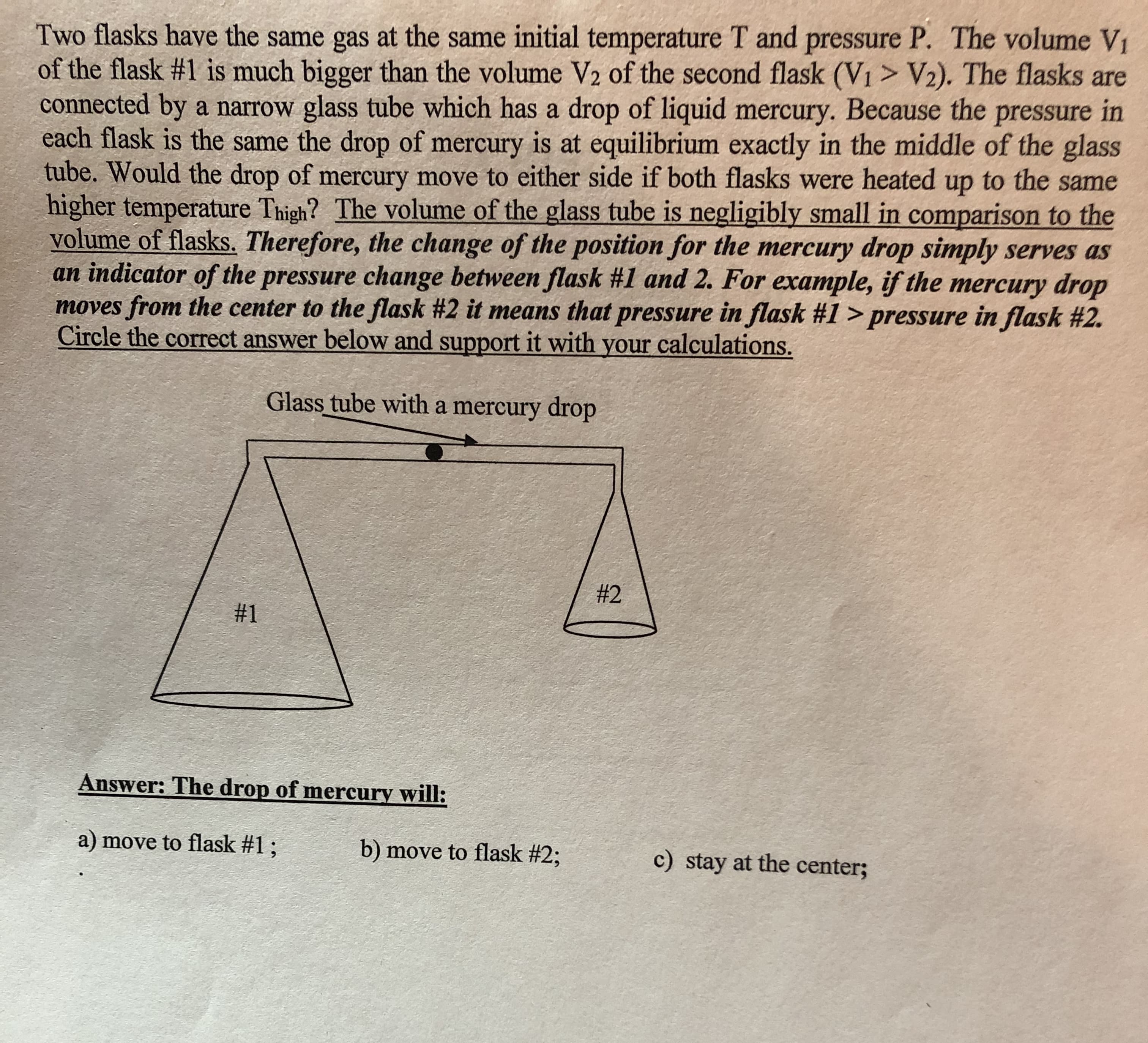Two flasks have the same gas at the same initial temperature T and pressure P. The volume V of the flask #1 is much bigger than the volume V2 of the second flask (Vi > V) The flasks are connected by a narrow glass tube which has a drop of liquid mercury. Because the pressure in each flask is the same the drop of mercury is at equilibrium exactly in the middle of the glass tube. Would the drop of mercury move to either side if both flasks were heated up to the same higher temperature Thigh? The volume of the glass tube is negligibly small in comparison to the volume of flasks. Therefore, the change of the position for the mercury drop simply serves as an indicator of the pressure change between flask #1 and 2. For example, if the mercury drop moves from the center to the flask #2 it means that pressure in flask #1 > pressure in flask #2. Circle the correct answer below and support it with your calculations. Glass tube with a mercury drop #2 #1 Answer: The drop of mercury will: a) move to flask #1 ; b) move to flask #2; c) stay at the center;
Two flasks have the same gas at the same initial temperature T and pressure P. The volume V of the flask #1 is much bigger than the volume V2 of the second flask (Vi > V) The flasks are connected by a narrow glass tube which has a drop of liquid mercury. Because the pressure in each flask is the same the drop of mercury is at equilibrium exactly in the middle of the glass tube. Would the drop of mercury move to either side if both flasks were heated up to the same higher temperature Thigh? The volume of the glass tube is negligibly small in comparison to the volume of flasks. Therefore, the change of the position for the mercury drop simply serves as an indicator of the pressure change between flask #1 and 2. For example, if the mercury drop moves from the center to the flask #2 it means that pressure in flask #1 > pressure in flask #2. Circle the correct answer below and support it with your calculations. Glass tube with a mercury drop #2 #1 Answer: The drop of mercury will: a) move to flask #1 ; b) move to flask #2; c) stay at the center;
Chemistry
10th Edition
ISBN:9781305957404
Author:Steven S. Zumdahl, Susan A. Zumdahl, Donald J. DeCoste
Publisher:Steven S. Zumdahl, Susan A. Zumdahl, Donald J. DeCoste
Chapter5: Gases
Section: Chapter Questions
Problem 102E: Xenon and fluorine will react to form binary compounds when a mixture of these two gases is heated...
Related questions
Question
100%
Can you please help me solve this problem and explain how you got the answers?

Transcribed Image Text:Two flasks have the same gas at the same initial temperature T and pressure P. The volume V
of the flask #1 is much bigger than the volume V2 of the second flask (Vi > V) The flasks are
connected by a narrow glass tube which has a drop of liquid mercury. Because the pressure in
each flask is the same the drop of mercury is at equilibrium exactly in the middle of the glass
tube. Would the drop of mercury move to either side if both flasks were heated up to the same
higher temperature Thigh? The volume of the glass tube is negligibly small in comparison to the
volume of flasks. Therefore, the change of the position for the mercury drop simply serves as
an indicator of the pressure change between flask #1 and 2. For example, if the mercury drop
moves from the center to the flask #2 it means that pressure in flask #1 > pressure in flask #2.
Circle the correct answer below and support it with your calculations.
Glass tube with a mercury drop
#2
#1
Answer: The drop of mercury will:
a) move to flask #1 ;
b) move to flask #2;
c) stay at the center;
Expert Solution
This question has been solved!
Explore an expertly crafted, step-by-step solution for a thorough understanding of key concepts.
This is a popular solution!
Trending now
This is a popular solution!
Step by step
Solved in 4 steps with 1 images

Knowledge Booster
Learn more about
Need a deep-dive on the concept behind this application? Look no further. Learn more about this topic, chemistry and related others by exploring similar questions and additional content below.Recommended textbooks for you

Chemistry
Chemistry
ISBN:
9781305957404
Author:
Steven S. Zumdahl, Susan A. Zumdahl, Donald J. DeCoste
Publisher:
Cengage Learning

Chemistry: An Atoms First Approach
Chemistry
ISBN:
9781305079243
Author:
Steven S. Zumdahl, Susan A. Zumdahl
Publisher:
Cengage Learning


Chemistry
Chemistry
ISBN:
9781305957404
Author:
Steven S. Zumdahl, Susan A. Zumdahl, Donald J. DeCoste
Publisher:
Cengage Learning

Chemistry: An Atoms First Approach
Chemistry
ISBN:
9781305079243
Author:
Steven S. Zumdahl, Susan A. Zumdahl
Publisher:
Cengage Learning


Chemistry by OpenStax (2015-05-04)
Chemistry
ISBN:
9781938168390
Author:
Klaus Theopold, Richard H Langley, Paul Flowers, William R. Robinson, Mark Blaser
Publisher:
OpenStax

General Chemistry - Standalone book (MindTap Cour…
Chemistry
ISBN:
9781305580343
Author:
Steven D. Gammon, Ebbing, Darrell Ebbing, Steven D., Darrell; Gammon, Darrell Ebbing; Steven D. Gammon, Darrell D.; Gammon, Ebbing; Steven D. Gammon; Darrell
Publisher:
Cengage Learning

Introductory Chemistry: An Active Learning Approa…
Chemistry
ISBN:
9781305079250
Author:
Mark S. Cracolice, Ed Peters
Publisher:
Cengage Learning